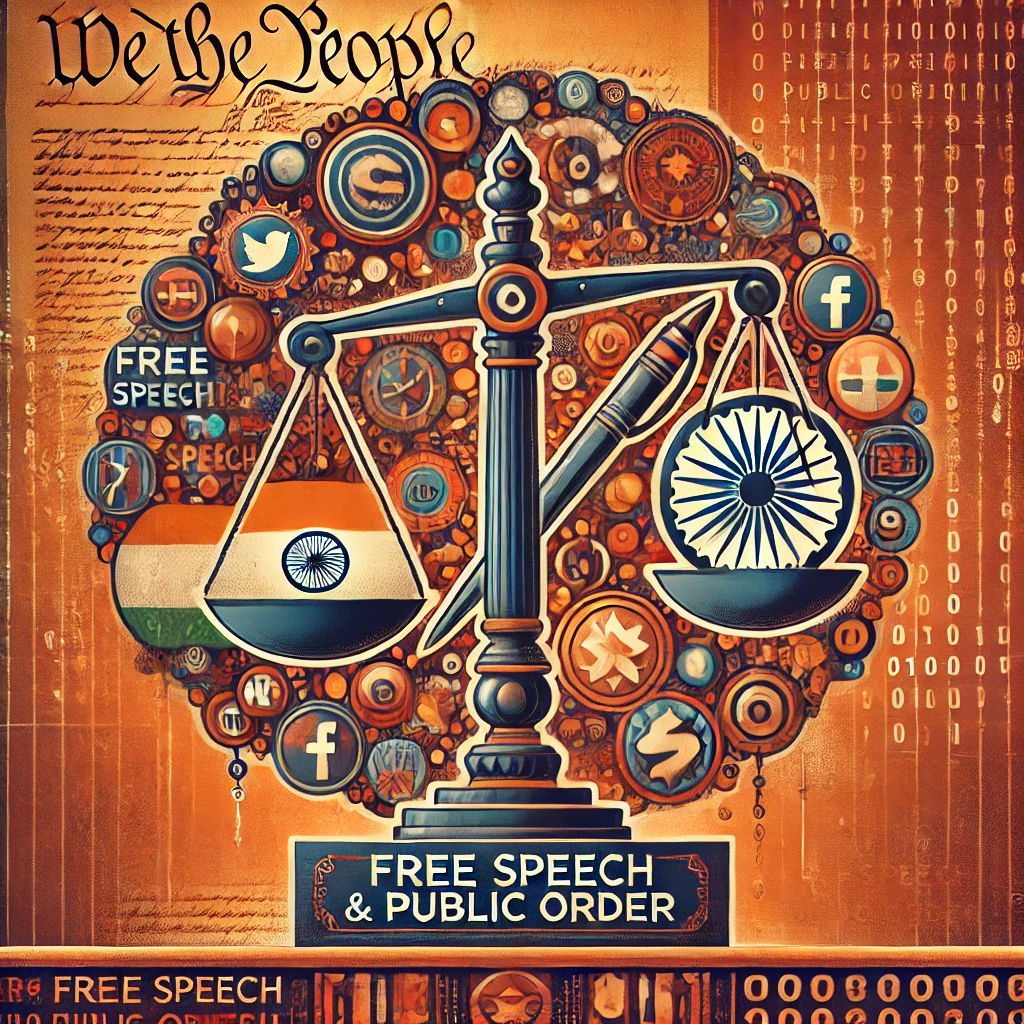
This article has been written by Ahmad Usman, a law student at Lloyd Law College.

*This article has been selected for LegalOnus Law Journal (LLJ) Volume 1, Issue 3, 2024.
Abstract:
This paper explores the legal standards of the Proximate and Tendency Tests used by Indian courts to balance free speech and public order. In democratic societies like India, freedom of speech, as enshrined under Article 19(1)(a) of the Constitution, is a fundamental right. However, Article 19(2) permits the State to impose reasonable restrictions on this right, including for public order concerns. The judiciary employs both the Proximate and Tendency Tests to evaluate whether speech poses a sufficient threat to justify restrictions. While both tests aim to maintain public peace, they differ significantly in their criteria and implications.
The Proximate Test requires a close and immediate connection between speech and the risk of public disorder, adhering to a “clear and present danger” standard. Based on the jurisprudential roots of Justice Holmes’s famous doctrine from Schenck v. United States (1919), this test has been favored by the Indian judiciary. It demands evidence of an imminent threat, preventing restrictions based on hypothetical or distant dangers. This approach was upheld in landmark cases such as Superintendent, Central Prison, Fatehgarh v. Ram Manohar Lohia (1960), where the Supreme Court emphasized that only speech that directly incites immediate disorder should be restricted. More recently, the Shreya Singhal v. Union of India (2015) judgment reiterated the Proximate Test’s role in protecting free expression, especially in the digital age.
In contrast, the Tendency Test allows for speech restrictions based on the potential or tendency of the expression to disrupt public order, without requiring an immediate or direct connection. This standard stems from the “bad tendency” doctrine, a broader approach granting the government preventive powers to restrict speech that may incite gradual social unrest. Historically, the Tendency Test was applied in colonial India to curtail dissenting voices under laws such as the Indian Press Act of 1910. In Kedar Nath Singh v. State of Bihar (1962), the Supreme Court upheld Section 124A of the IPC (sedition), indicating that speech with a tendency to incite violence could be curtailed under this test. However, the judiciary has generally avoided the Tendency Test in recent rulings, given its potential to lead to arbitrary restrictions and undue government control over speech.
Through a comparative analysis, this paper underscores the distinct features of the two tests. The Proximate Test, with its high threshold for restriction, safeguards democratic values by limiting state intervention. The Tendency Test, while useful for preventive action, presents risks of overreach, potentially stifling free expression. The paper discusses these tests’ applications in the Indian legal landscape, noting the judiciary’s preference for the Proximate Test as a way to uphold constitutional freedoms.
In conclusion, while both tests are vital tools in the interplay between free speech and public order, the Proximate Test aligns more closely with democratic ideals. Nonetheless, with the rapid evolution of digital communication, courts may need to consider new approaches to maintain this delicate balance in the future. This paper highlights the importance of adapting these principles to contemporary challenges without compromising individual rights.
Keywords: Proximate test, Tendency Test, Public Order, Freedom of Speech.
Introduction:
The right to freedom of speech is a cornerstone of democratic societies, enabling individuals to express ideas, debate, and engage in civic discourse. However, this freedom is not without limits, especially when public order is at risk. In India, as in many democracies, the courts have crafted legal standards to determine when restrictions on speech are justified to prevent disruptions. Two prominent standards, the Proximate Test and the Tendency Test, serve as essential tools in this analysis.
While both tests examine the link between speech and the potential for disorder, they differ significantly in their scope and application. The Proximate Test requires an immediate, direct connection to public disorder, whereas the Tendency Test looks for a broader, more generalized risk. This article explores the origins, applications, and consequences of these tests in India, emphasizing their implications on the balance between free expression and public order.
Free Speech and Public Order in the Indian Context
In India, Article 19(1)(a) of the Constitution guarantees the right to free speech, allowing citizens to communicate their ideas freely. However, Article 19(2) allows the State to impose reasonable restrictions on this right for the sake of public order, among other concerns. The Indian judiciary has consistently emphasized that these restrictions must be carefully calibrated to protect public order without infringing unnecessarily on free speech.
This is where the Proximate and Tendency Tests come into play. By providing distinct legal frameworks, these tests allow the courts to evaluate whether restrictions on speech are necessary and proportionate, aiming to uphold democratic values while maintaining societal peace.
The Proximate Test: A High Threshold for Restricting Speech
The Proximate Test is a standard that limits speech restrictions to cases where a direct and immediate threat to public order is present. In other words, under the Proximate Test, speech can only be curtailed if it has a clear, strong probability of inciting immediate public disorder.
- Origins of the Proximate Test
The Proximate Test is based on the principle of “clear and present danger,” a concept that emerged from Justice Oliver Wendell Holmes Jr. in the U.S. case Schenck v. United States (1919). Holmes argued that speech could be restricted only if it poses a “clear and present danger” of causing harm that the government has a right to prevent.
This principle resonated in Indian jurisprudence, as the Indian judiciary sought to protect free speech while allowing the government to curb speech that posed a real threat to public order. The Proximate Test thus reflects a commitment to limiting restrictions on speech to cases where there is a high likelihood of immediate harm.
- Proximate Test in Indian Jurisprudence
The Supreme Court of India has often applied the Proximate Test when interpreting restrictions on free speech, particularly in cases involving public order. A landmark case, Superintendent, Central Prison, Fatehgarh v. Ram Manohar Lohia (1960), set an important precedent by emphasizing the need for a close, proximate link between speech and public disorder. The court held that restrictions must be connected to a serious and immediate threat, reinforcing that vague or hypothetical threats are not sufficient grounds for curbing free speech.
In more recent cases, such as Shreya Singhal v. Union of India (2015), the Supreme Court struck down Section 66A of the Information Technology Act, citing the importance of clarity and specificity in speech restrictions. The Court underscored that restrictions should only apply to speech that incites imminent violence or disorder, upholding the Proximate Test as a necessary standard for safeguarding free speech.
- Advantages and Challenges of the Proximate Test
The Proximate Test has significant advantages for freedom of speech, as it sets a high bar for state intervention. By requiring a direct and immediate threat, the test minimizes the risk of unnecessary restrictions, preserving individuals’ rights to express dissent or unpopular opinions.
However, the Proximate Test’s strict requirements can also limit the government’s ability to act preventively. In cases where speech incites cumulative harm or slower-burning social disruptions, the Proximate Test may make it difficult to restrict speech in time to prevent escalation.
The Tendency Test: A Broader Approach to Preventive Action
In contrast to the Proximate Test, the Tendency Test allows the restriction of speech if it merely has a tendency to disrupt public order. Under this test, authorities can impose restrictions based on the potential or likelihood of harm, without requiring a direct or immediate threat.
- Origins and Legal Foundations of the Tendency Test
The Tendency Test traces its roots to the “bad tendency” doctrine, which permits restrictions on speech that could, in some way, lead to public disorder. Historically, this test has been applied to curb speech that authorities believe has the potential to incite social unrest or disrupt peace.
In colonial India, the Tendency Test allowed broad state control over publications and speeches. For example, the Indian Press Act of 1910 imposed restrictions on publications with “bad tendencies” to suppress critical voices against British rule. This approach to regulation favored preventive action over the protection of free speech.
- Application of the Tendency Test in Indian Law
Indian courts have occasionally used the Tendency Test in cases involving speech that has the potential to incite violence or public disorder, even if the threat is not immediate. One notable case, Kedar Nath Singh v. State of Bihar (1962), addressed the constitutionality of Section 124A of the Indian Penal Code (sedition). The Supreme Court upheld the section, noting that speech that “tends” to incite violence or disrupt public order can be restricted, thereby applying a form of the Tendency Test.
However, the judiciary has largely moved away from this approach in favor of more stringent standards, as seen in cases like S. Rangarajan v. P. Jagjivan Ram (1989). In this case, the Court rejected the Tendency Test, emphasizing the importance of a direct and immediate connection to public disorder. This decision reflected the judiciary’s preference for narrower restrictions on speech, highlighting the potential for the Tendency Test to infringe upon fundamental rights.
- Strengths and Limitations of the Tendency Test
The Tendency Test is advantageous for authorities who seek to prevent unrest, as it allows for restrictions based on general potential rather than specific threats. This approach is useful in cases where speech may gradually lead to disorder, such as inflammatory rhetoric or propaganda.
However, the Tendency Test is highly susceptible to overreach. By focusing on vague risks, it grants the government considerable discretion, potentially leading to arbitrary or unjustified restrictions on speech. This can undermine democratic principles, as it allows the government to limit dissent or unpopular opinions based on hypothetical threats rather than concrete risks.
Comparing the Proximate and Tendency Tests
The Proximate and Tendency Tests represent two distinct approaches to balancing free speech and public order. Below is a comparative analysis of their key aspects:
| Aspect | Proximate Test | Tendency Test |
| Focus | Direct, immediate threat to public order | General tendency to disrupt public order |
| Threshold | High – requires clear and present danger | Low – based on potential risk |
| Implications | Protects free speech with strict criteria | Allows preventive action but risks overbroad limits |
| Risk of Abuse | Low, as it requires clear proof of imminent harm | High, as it can lead to vague or arbitrary restrictions |
The Proximate Test: A Preferred Standard for the Indian Judiciary
The Indian judiciary has generally favored the Proximate Test, emphasizing that speech restrictions should be narrow and linked to an immediate threat. This preference is grounded in democratic principles, which prioritize individual rights and restrict state interference unless absolutely necessary.
In the landmark Shreya Singhal v. Union of India case, the Supreme Court articulated that “mere discussion or advocacy, no matter how unpopular, should not be restricted unless it incites imminent violence.” This judgment underscored the Proximate Test’s importance in protecting free speech while upholding the need for public order.
Challenges and Future Directions
Despite its clear benefits, the Proximate Test presents challenges. In an age of digital communication, where harmful content can spread rapidly and subtly incite unrest, the need for preventive measures has increased. Social media and online platforms can quickly amplify speech that might initially appear innocuous but could lead to cumulative harm.
Some legal experts argue that the Proximate Test may require adjustments to address these modern challenges, allowing for a more nuanced approach to online speech. However, any shift towards a broader interpretation must be carefully managed to prevent overreach.
Conclusion
The Proximate and Tendency Tests play a crucial role in balancing free speech and public order, offering distinct frameworks for assessing the risk of speech-related disruptions. The Proximate Test aligns closely with democratic principles, demanding clear, immediate threats before speech can be restricted. The Tendency Test, while useful for preventive action, carries risks of arbitrary or excessive state control.
In India, the judiciary’s preference for the Proximate Test reflects a commitment to safeguarding free speech while maintaining public order. Moving forward, the challenge lies in adapting these principles to address the complexities of modern communication without compromising fundamental rights






